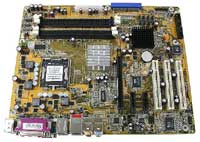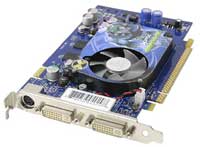Gaming Buyer's Guide - November 2004
by Jarred Walton on November 21, 2004 5:54 PM EST- Posted in
- Guides
Intel Budget Gaming System
At the lowest end of the spectrum, AMD doesn't have quite as much of an advantage in performance over Intel, since the CPU is less of a bottleneck, and there is one item that Intel can offer which AMD cannot (yet): PCI Express. Suffice it to say that especially for die-hard Intel fans, they are not a terrible choice, although they do cost slightly more. Here is our best attempt at matching the Budget AMD system's price and performance.| Budget Intel Pentium 4 System | ||
| Hardware | Recommended Component | Price |
| Processor | Pentium 4 520 2.8 GHz 1MB Cache | 158 |
| Motherboard | DFI 915P-TAG i915P | 118 |
| Memory | 1x512MB Mushkin Basic 2.5-4-4 | 75 |
| Video Card | XFX GeFORCE 6600GT 128 MB | 178 |
| Hard Drive | Seagate Barracuda 80GB EIDE model 7200.7 | 59 |
| Optical Drive | NEC DVD+/-RW Drive Model 3500A | 72 |
| Case and Power Supply | Athenatech A602 Black/Silver with 350W PSU | 62 |
| Display | Samsung 793DF 17 Black/Silver CRT (1280x1024@75 Hz) | 139 |
| Speakers | Logitech Z-640 5.1 | 52 |
| Keyboard and Mouse | Logitech Optical Desktop Combo | 26 |
| Bottom Line | 939 | |
 Click to enlarge. |
 Click to enlarge. |
Another drawback is that dual-channel RAM helps the Pentium 4 more than it does the Athlon 64, so using only one DIMM is going to cut into that performance boost a bit. If you plan on adding 512MB of RAM in the near future, that's not too big of a problem. Otherwise - and we hesitate to say this as they may not be of much use in future systems - using two 256 MB DIMMs will cost about the same as a single 512 MB DIMM. The extra $70 or so spent on an Intel system could be put into other items like a better graphics card or a faster CPU, and AMD also has the 64-bit factor to consider. This is why we still give AMD our primary recommendation, but it really is a close match-up in this price bracket.
Besides shipping PCI Express support, Intel also has their HyperThreading feature, which can help in certain multi-tasking applications. We have not yet seen any performance benefit to HyperThreading in the gaming realm - quite the reverse, in fact, as most games run a few percent slower with HTT enabled - but that could change in the future. With both AMD and Intel shifting away from increasing clock speeds to multi-core designs, it would make sense that games at some point will need to shift to a multi-threaded programming environment in order to extract the most performance from the processor. HTT ends up being nothing that we are overly concerned with as far as games go, but it's still there and it could come into play in the next year or two.
If you feel that our budget recommendations are almost impractical, just take that as an indication of the difficulty of selecting parts for this price segment. These three platforms are all very capable, however, and none of them is truly a bad choice. If you're the type of person who upgrades parts frequently - i.e. more than twice a year - over the life of your system, the socket 939 and socket 775 platforms will be a better choice. From a pure price standpoint, socket 754 still wins out.










70 Comments
View All Comments
Arkali - Tuesday, November 23, 2004 - link
For Intel gaming you should have picked the new AOPEN socket 479 855GME motherboard and a Dothan processor.Glassmaster - Monday, November 22, 2004 - link
#30 Doesn't look like they are going to defend their PSU recommendations. I just want to know if they actually build and stress test these systems with the Generic PSUs to make sure their recommended systems really are reliable.Glassmaster.
Live - Monday, November 22, 2004 - link
I like the format of this guide. I think the guides in general has been a great addition to Anandtech.To bad PCI-e motherboards is not out yet. Since the sli previews are not out in force yet I'm still not 100% sure if its something you want on your motherboard for more upgradability but it sure looks like it is not. Too expensive both in terms of motherboard and the 2 cards. But for a gamer, investing in anything else then PCI-e seems like a bad move. Unless you like to buy second-hand. I bet a lot of AGP cards will soon be available on the market as the high end crowd switches to the latest.
mldeveloper - Monday, November 22, 2004 - link
i like the format of this guide, since i always jumped to the end to see the final price breakdown anyway.nurazlanshah - Monday, November 22, 2004 - link
is the a big difference in fps between 128mb and 256mb for a same graphic card?deathwalker - Monday, November 22, 2004 - link
Jarod...great writeup. Ignore all the sniping. It's a tough job doing a article like this and sometimes there just aren't any absolute rights and wrongs. Somepeople just like to pipe-off and be heard.AaronAxvig - Monday, November 22, 2004 - link
#15 I think if you really wanted maximum performance for a LOT of money, you would go with RAIDed SCSI. Very fast, no?Momental - Monday, November 22, 2004 - link
Fantastic article, Trog......I mean Jarrod. ;)I was considering going the SLI route with (2) two 6600GT's, but then realized that the performance is identical to that of one 6800GT. And who wants to take the chance of one of the GPU's defecating the bed? Additionally, the cost of the SLI-capable board ain't gonna be cheap. I will, however, wait for the VIA and nVidia PCI-e boards to become available before finally building a new system.
The only thing I might change from the mid-range system is to put in the lower latency RAM, such as the OCZ Plat Rev. 2 or the Ballistix. Pop on a good aftermarket HSF on the CPU and we're good to go!!
gilkman - Monday, November 22, 2004 - link
Very nice article. It's been a few years since my last homebuilt but with the new games it's def time to upgrade. I like the format of this article. It gives me a few more options and insight compared to the similar guides they have over at sharkeyextreme.comI am def looking at high end parts to put together and I was very interested in the Dell 20 inch widescreen LCD - Does anyone have any comments on using a widescreen LCD for games? The Dell widescreen has 16MS refresh and high resolutions, and I know that HL2 will support widescreen play, but what about other modern games like RTS's and RPG's? Is it safer to stick with a 4:3 screen?
SDA - Monday, November 22, 2004 - link
Looks good, but I object to using a cheap PSU for a lot of the systems. It's worth the small amount of extra money you pay to get a better PSU... a TON of the problems I've seen in DIY systems resulted from cheapo PSUs that couldn't deliver enough power or simply couldn't deliver clean enough power. Cheap PSU = false savings, IMHO. There are plenty of good PSUs out there for cheap (TTGI, CWT aka Antec).And yeah, sure, the budget rigs don't stress the PSU much. I still hold that you shouldn't go generic. Having looked inside a lot of generic PSUs, I can safely say that I wouldn't ever want to see one in ANY system I build.